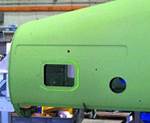Ply placement: Largest laser projection system for wind blade manufacture
Following the recent installation of a 16-projector system for an aircraft fuselage application, Assembly Guidance Systems Inc. (Chelmsford, Mass.) recently delivered what it says is the largest unified laser-projection system of its kind, for wind turbine blade fabrication.
Following the recent installation of a 16-projector system for an aircraft fuselage application, Assembly Guidance Systems Inc. (Chelmsford, Mass.) recently delivered what it says is the largest unified laser-projection system of its kind, for wind turbine blade fabrication. Made of 20 projectors, the LASERGUIDE system, equipped with the company’s Multitasking capability, enables multiple technicians to work independently and simultaneously in different zones of a large wind turbine blade tool.
During part fabrication, the LASERGUIDE system projects templates of light via laser onto the composite tool, outlining the exact location for layup of composite materials, and it does so in the proper sequence, according to the job’s ply schedule. Technicians simply place plies within the projected template, which is based on three-dimensional design data, typically from CAD files. Each 18-lb/8-kg projector (mounted to existing structures or to fixed or portable stands) focuses the template image automatically and can project lines over a distance of 50 ft/16m with good resolution.
For wind turbine blade customers, a single computer supports the 20 projectors and eight remote controls. It is not necessary to synchronize multiple computers or wait for completion of other activities. For such a large integrated system, Assembly Guidance enhanced the system’s Multitasking function: Each individual projector can display multiple templates, even from multiple jobs, simultaneously. This reduces the cycle time and brings operational and facilities costs in line with lean manufacturing practices, claims Assembly Guidance’s president, Scott Blake.
The blade manufacturer selected the LASERGUIDE system following a year-long evaluation process because it reportedly outperforms competing systems in such areas as line visibility on challenging materials, such as mats and thick multiaxial glass fabrics. Additionally, the projectors are more easily positioned and are equipped with multiple remote controls. During the evaluation process, Assembly Guidance also provided customized solutions, technical support and applications aid for the blade parts.
Related Content
-
Drag-based wind turbine design for higher energy capture
Claiming significantly higher power generation capacity than traditional blades, Xenecore aims to scale up its current monocoque, fan-shaped wind blades, made via compression molded carbon fiber/epoxy with I-beam ribs and microsphere structural foam.
-
Honda begins production of 2025 CR-V e:FCEV with Type 4 hydrogen tanks in U.S.
Model includes new technologies produced at Performance Manufacturing Center (PMC) in Marysville, Ohio, which is part of Honda hydrogen business strategy that includes Class 8 trucks.
-
Infinite Composites: Type V tanks for space, hydrogen, automotive and more
After a decade of proving its linerless, weight-saving composite tanks with NASA and more than 30 aerospace companies, this CryoSphere pioneer is scaling for growth in commercial space and sustainable transportation on Earth.
















